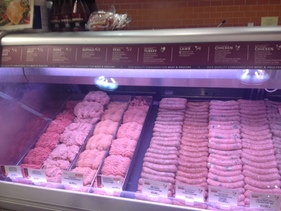Researching and then some…….
Our research project has been coming along quite nicely. On Thursday, April 19th, we took a trip to Whole Foods Market in Marlton, NJ. Neither of us have ever been in a whole foods market and were quite blown away by the displays and variety of foods that they offer. We made our way over to the meat department where we were “WOWED” with quite a display of meat. The meat was not pre-packaged but rather displayed in cases. Costumers made their ways up to the counter and told the butchers what they like. The meat was labeled with individual descriptions and their ratings.
We had decided to change our project once again, but this time for the last time! Now we are researching the difference between the meats sold at Whole Foods and the meats sold at Shop Rite. We took separate trips to Shop Rite and bought meat. We both spoke to the butcher’s on our separate visits (at separate stores) but received similar responses when asked where the beef comes from. Danielle’s butcher couldn’t really tell her, he had no idea. Angela’s butcher went on and on to say how Shop Rite makes sure to buy only high quality meat with no pink slime. The problem is, the question wasn’t about pink slime, the question was, “Where does the beef come from?” Angela’s butcher had no concrete answer either.
Since Friday we have both performed individual taste testing on the meat at home. Danielle prepared burgers for her family and Angela prepared meatballs for her family. The results are pretty interesting and we will share our results very soon! We are both very busy composing more research on Shop Rite and Whole Foods as we speak. We are both very excited about our new topic and can’t wait to see where our results lead us.


 RSS Feed
RSS Feed